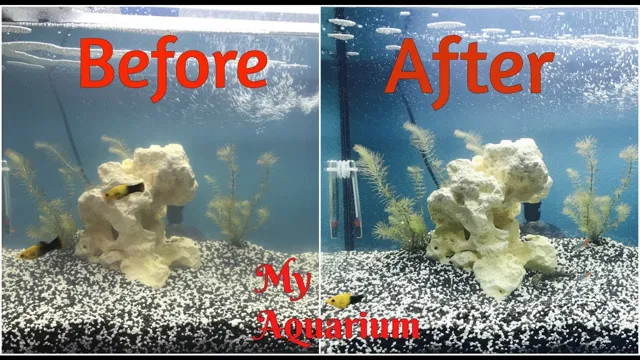Keeping a planted aquarium is a beautiful way to introduce one of nature’s most beautiful and diverse ecosystems into your home. As it is crucial to maintain a healthy and stable aquatic environment, many aquarists run into the challenge of maintaining clear and algae-free water. An unbalanced ecosystem or careless management of waste and nutrients can lead to murky water, which will prevent your plants from thriving and can also be harmful to fish and other aquatic organisms.
Fear not, as there are effective ways to maintain clear water in a planted aquarium without resorting to harsh chemicals or costly equipment. In this article, we will explore some simple solutions on how to keep planted aquarium water clear, including natural methods and best practices that will improve the health and appearance of your aquatic garden.
Understand the Causes of Cloudy Water
If you’re struggling to keep your planted aquarium water clear, there may be several causes for the cloudy appearance. Poor filtration, excessive feeding, overstocking, and waste from fish and plants can all contribute to cloudy water. Additionally, a build-up of organic pollutants or an unbalanced pH level can also obstruct the clarity of the water.
To remedy these issues, you may need to adjust your feeding habits, increase water changes, add more plants and fish, or upgrade your filtration system. Ensuring the right balance of nutrients and pH levels will also help stabilize the water quality and clarity. Keep an eye on the tank inhabitants and regularly test the water quality to ensure a healthy and clear environment for your aquatic pets.
Imbalanced Nutrients and Light
When it comes to cloudy water in your aquarium, imbalanced nutrients and light are major culprits. Nutrients like nitrates and phosphates can accumulate and promote the growth of algae and bacteria, making the water cloudy. On the other hand, inadequate or excessive lighting can cause an imbalance in the tank’s ecosystem, leading to microbial blooms and poor water quality.
It’s essential to strike a balance between proper lighting duration, intensity, and nutrient levels in your tank to prevent cloudy water. Regular water changes and proper filtration can also help maintain optimal conditions for your aquatic pets. Remember, cloudy water is not just an aesthetic issue; it can harm your aquatic inhabitants’ health and wellbeing.
Keep an eye on the nutrient and light levels in your aquarium and take appropriate action to maintain a healthy and thriving aquatic environment.

Overfeeding and Uneaten Food
Overfeeding and Uneaten Food can lead to cloudy water in fish tanks, which can be very frustrating and unappealing. This is a common problem that many new fish keepers face. Overfeeding causes an excess of uneaten fish food to accumulate in the tank, leading to the growth of bacteria and algae, which causes the water to become cloudy.
Additionally, uneaten fish food can rot and release toxic chemicals into the water, which can be harmful to fish and other aquatic life. It’s important to avoid overfeeding your fish and to ensure that all uneaten food is removed from the tank. A good practice is to feed your fish small amounts multiple times a day instead of one or two large meals.
This way, you can monitor how much food is consumed and remove any uneaten food after a few minutes. By taking care of these factors, you can maintain a clean, healthy, and aesthetically pleasing fish tank.
Lack of Water Flow and Filtration
If you are experiencing cloudy water in your swimming pool, the culprit might be a lack of water flow and filtration. This problem is often due to a clogged or dirty filter, which prevents water from moving through the system properly. When water is not flowing efficiently, it can lead to cloudy water and make it difficult to maintain proper chemical balance.
Poor circulation and filtration can also lead to the accumulation of organic debris, including leaves, bugs, and other contaminants. To address this issue, you should check your filter and make sure it is clean and functioning correctly. You should also ensure that your pool pump is appropriately sized and running for the recommended amount of time each day.
By addressing these issues, you can enjoy crystal-clear water in your pool and keep your swimmers safe and healthy. Remember, proper water flow and filtration are essential components of a healthy swimming pool.
Monitor Water Parameters Regularly
Keeping your planted aquarium water clear and healthy is essential for the health of your fish and plants. One crucial aspect of achieving this is by monitoring your water parameters regularly. One of the significant determinants of the water quality in your aquarium is its pH level.
Ensuring that it remains within the optimal range of 5 to 5 is critical in maintaining a healthy environment for your aquatic life.
Another essential parameter is the level of nitrates. High levels of nitrate can lead to algae growth and harm your fish and plants. Regular monitoring and water changes can help keep the nitrate levels under control. (See Also: How to Breed Shrimp in an Aquarium: A Comprehensive Guide for Beginnners)
Testing your water for ammonia, nitrite, and phosphate levels is also necessary. If you notice any spikes in these levels, take immediate action, or your aquarium can encounter problems. Regularly monitoring your water parameters and taking corrective measures when necessary goes a long way in keeping your aquarium water clear and healthy, ultimately leading to a thriving aquatic community in your tank.
pH, Ammonia, Nitrite, and Nitrate Levels
Maintaining the perfect balance of pH, ammonia, nitrite, and nitrate levels in your aquarium is crucial for the health and survival of your aquatic pets. Regularly monitoring these water parameters is necessary to ensure your fish and other aquatic life thrive in their environment. pH is a measure of acidity or alkalinity and should be kept within a specific range depending on the species of fish you have.
Ammonia is harmful to fish in even small quantities and must be kept at undetectable levels. Nitrite is produced during the nitrogen cycle and can cause fish to suffocate by impairing their ability to uptake oxygen. Nitrate is less toxic than ammonia and nitrite, but high levels can still harm fish and other aquatic organisms.
Monitoring these levels will help you catch any imbalances early and take corrective actions before they become a bigger problem. Just like a doctor checks vital signs regularly to keep patients healthy, checking water parameters regularly is essential for aquarium health.
Temperature and Oxygen Levels
When it comes to maintaining a healthy aquarium, one of the most important things you can do is regularly monitor the water parameters. Two critical factors to keep an eye on are the temperature and oxygen levels. These two parameters play a significant role in the health and survival of your aquatic pets and plants.
Fish and other aquatic creatures are highly sensitive to water temperature, and any significant fluctuations can cause stress, illness, or even death. Therefore, it’s essential to use a reliable thermometer to monitor the water temperature daily and make any necessary adjustments. Additionally, oxygen is vital for the metabolic processes of your aquarium’s inhabitants.
Low oxygen levels can lead to poor health, behavior problems, and even death. Hence, ensuring adequate aeration and filtration to prevent oxygen depletion is crucial. In summary, never underestimate the importance of monitoring temperature and oxygen levels in your aquarium.
By doing so, you can ensure a healthy and thriving aquatic ecosystem for your pets.
Regular Water Changes
One of the easiest ways to keep your planted aquarium water clear is by performing regular water changes. This is an essential part of aquarium maintenance, and it’s crucial to keep the water clean and healthy for your aquatic plants and fish. A water change involves removing a portion of the old water and replacing it with fresh, clean water.
It’s important to note that the frequency and amount of water changes depend on the size of your aquarium, the number of fish and plants in it, and the type of filter system you’re using. Typically, a 10-25% water change every week or two is recommended. Remember, investing in a good quality water testing kit can help you determine when it’s time to perform a water change and ensure that your water parameters remain stable.
By regularly performing water changes, you’ll not only maintain a clear and healthy environment for your plants and fish but also help prevent potentially harmful toxins from building up in the water.
Remove Debris and Waste
Regular water changes are an essential part of aquarium maintenance and can significantly impact the health and wellbeing of your aquatic animals. However, it’s not just simply pouring out old water and adding in new water. It’s important to remove any debris and waste that may have accumulated in the tank, such as excess food, dead plant matter, and fish waste.
Failure to do so can lead to an increase in harmful chemicals such as ammonia and nitrites, which can be deadly to your fish and other animals. By regularly changing the water, you can dilute these toxins and provide a healthier environment for your aquatic pets. Aim to change about 10-20% of the aquarium water every one to two weeks, depending on the size of your tank and the number of inhabitants.
By doing so, you’ll be removing debris and waste while also refreshing the water and keeping your pets happy and healthy.
Maintain Consistent Water Quality
One of the most important things to keep in mind when maintaining an aquarium is the quality of the water. Regular water changes are crucial for ensuring that the water remains clean and balanced. But how often should you change the water? The answer largely depends on the size and population of your aquarium. (See Also: How to Keep Aquarium Plants from Dying: The Ultimate Guide to a Thriving Underwater Garden)
As a general rule, you should aim to change 10-20% of the water every 1-2 weeks. This will remove any built-up nitrates, which can be harmful to fish and other aquatic life. Additionally, regular water changes can help to replenish trace elements and minerals that are essential to the health and wellbeing of your aquarium.
So don’t neglect this important aspect of aquarium maintenance! By keeping the water clean and balanced, you’ll be ensuring that your fish and other aquatic creatures remain healthy and happy.
Invest in a Quality Filtration System
Investing in a quality filtration system is a crucial factor in keeping your planted aquarium water clean and clear. A good filtration system will remove impurities like excess food, fish waste, and algae, which can cloud your water and harm your plants and fish. With so many different types of filtration systems available, it’s essential to choose one that matches the size of your aquarium and the specific needs of your aquatic plants and animals.
Whether you opt for a canister filter, power filter, or sponge filter, make sure it has the right filtration media, such as bio-media or activated carbon, to effectively remove waste from your aquarium water. Don’t skimp on the quality of your filtration system – investing in a reliable one is essential for the health and longevity of your planted aquarium.
Choose the Right Type and Size
Investing in a high-quality filtration system is crucial for maintaining clean and healthy water in your home. But with so many different types and sizes of filters available, it can be overwhelming to choose the right one. One of the first things to consider is the type of filter you need.
Some common options include carbon filters, reverse osmosis filters, and UV filters. Each type has its own strengths and weaknesses, so it’s important to do your research and choose the one that best fits your specific needs. Additionally, you’ll want to consider the size of the filter.
A larger filter will generally be more effective at removing contaminants, but it may also be more expensive. Ultimately, the key is to invest in a high-quality filtration system that will provide you with clean and healthy water for years to come.
Clean and Replace Filters as Needed
Investing in a quality filtration system for your home is one of the best decisions you could ever make. Such systems can help improve the air quality in your home by capturing and removing harmful airborne particles, allergens, and pollutants. And speaking of maintaining the system, one important task you should not overlook is cleaning and replacing filters as needed.
Doing so helps ensure that your filtration system continues to function efficiently and effectively. Clogged and dirty filters can impede airflow, which could cause the system to overwork and consume more energy than necessary. Plus, they could harbor harmful particles that could eventually get released back into your home.
To avoid these risks, it’s crucial to follow the manufacturer’s recommended filter maintenance schedule and replace filters at least every three months, or more frequently if you live in areas with high levels of air pollution or have pets. Whether you have a whole-house or a portable filtration system, keeping the filters clean and up-to-date will go a long way in protecting your health and well-being. So, invest in a top-quality filtration system today, and don’t forget to keep the filters fresh and clean for your benefit and that of your loved ones!
Choose the Right Plants
One of the most effective ways to keep your planted aquarium water clear is to choose the right plants. Some plants, such as Java Moss, Anubias, and Java Fern, are low-maintenance and help to purify the water by absorbing waste and excess nutrients. Other plants, such as Water Wisteria, Hornwort, and Amazon Sword, are excellent oxygenators and can help to maintain a healthy balance in your aquarium.
It’s important to research the specific needs of each plant before incorporating it into your tank, and to be mindful of the lighting and nutrient requirements of your aquatic plants to ensure optimal growth and water clarity. By carefully selecting the right plants, you can create a beautiful and vibrant planted aquarium that is also easy to maintain.
Select Plants that Thrive in Your Tank
Selecting the right plants for your aquarium is crucial to its overall health and aesthetic appeal. It’s important to choose plants that are compatible with your tank’s parameters, such as lighting, temperature, and pH levels. Some popular plants for aquariums include Java fern, Amazon sword, and Anubias.
These plants are easy to care for and can thrive in a variety of water conditions. When selecting plants, it’s also important to consider their growth habits and size. Some plants grow quickly and require frequent trimming, while others are slow-growing and may be more suitable for smaller tanks. (See Also: How to Bleach Aquarium Decorations: A Step-by-Step Guide to Safely Clean and Brighten Your Fish Tank Décor)
Additionally, consider the type of fish and other aquatic creatures you have in your tank. Some plants may provide hiding spots and protection for your fish, while others may be nibbled on by certain species. Overall, taking the time to research and select the right plants for your aquarium can lead to a beautiful and healthy aquatic environment for all its inhabitants.
Avoid Overstocking and Overcrowding
When it comes to keeping a freshwater aquarium, it’s important to choose the right plants for your tank. Overstocking and overcrowding can be major issues, and choosing the right plants can help prevent these problems from occurring. Some plants require more space and nutrients than others, so it’s important to do your research and select plants that are appropriate for your tank size and water conditions.
Plants like java fern and anubias can thrive in low-light, low-nutrient environments, making them ideal for smaller tanks or tanks with lower nutrient levels. On the other hand, stem plants like rotala and ludwigia can quickly grow and require frequent trimming, making them best suited for larger tanks with plenty of space. By selecting the right plants for your tank, you can create a healthy and beautiful environment for your aquatic pets.
Conclusion
In conclusion, keeping your planted aquarium water clear is a delicate balance of science and art. It requires the right combination of filtration, lighting, water changes, and diligent maintenance. But don’t forget the most important ingredient: love and dedication towards your aquatic plant babies.
With the right care, your underwater garden will not only be healthy and thriving, but it will also be a beautiful and peaceful oasis for you and your fishy friends to enjoy. So, let’s dive in and create a crystal clear aquatic paradise!”
FAQs
How often should I change the water in my planted aquarium to keep it clear?
It’s recommended to change 20-30% of the water in your planted aquarium every week to maintain water clarity.
Should I use a filter in my planted aquarium to keep the water clear?
Yes, a filter is essential in keeping your planted aquarium water clear as it removes debris, waste and other unwanted substances from the water.
What type of lighting should I use in my planted aquarium to keep the water clear?
LED lighting is the best choice for planted aquariums as it provides the optimal light spectrum for plant growth and does not produce excess heat that can affect water clarity.
Can adding live plants in my aquarium help keep the water clear?
Yes, live plants help remove excess nutrients from the water, reducing the growth of algae and bacteria that can affect water clarity.
Should I add carbon to my planted aquarium to keep the water clear?
Yes, adding activated carbon to your planted aquarium can help remove impurities from the water and increase water clarity.
How can I prevent algae growth in my planted aquarium to keep the water clear?
Regular maintenance, such as trimming plants, reducing lighting period and avoiding overfeeding fish, can help prevent algae growth, keeping the water clear.
What is the ideal temperature range for a planted aquarium to maintain clear water?
The ideal temperature range for most planted aquariums is between 72°F to 78°F as this temperature range promotes plant growth and prevents excessive bacterial and algae growth that can contribute to cloudy water.







